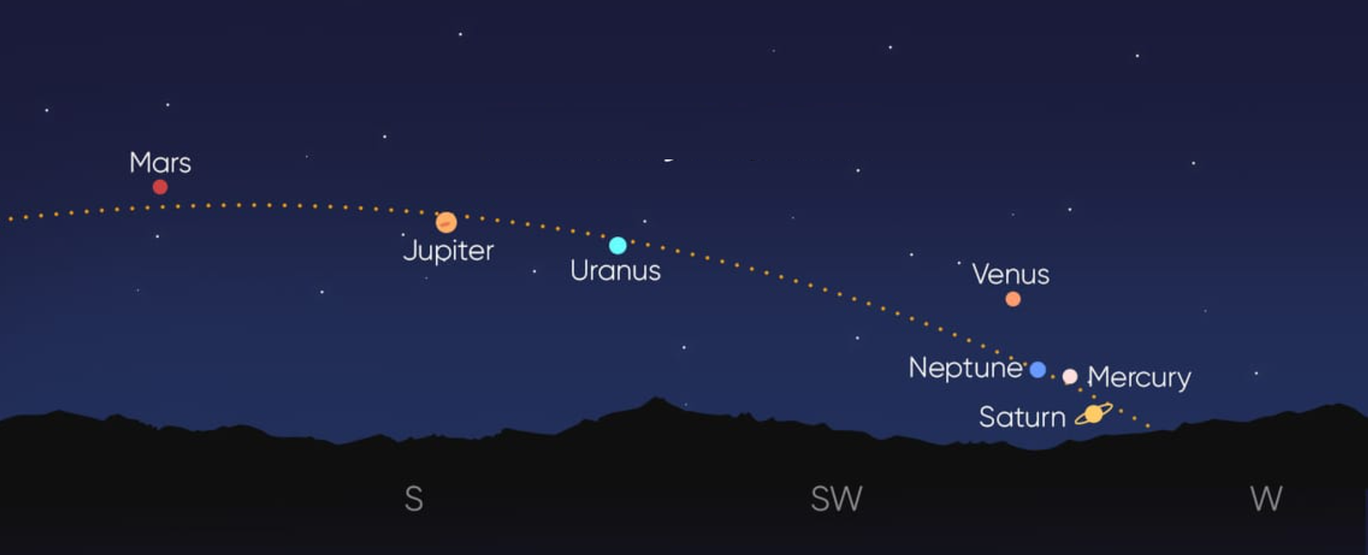Seven-Planet Alignment Dazzles the Night Sky on February 28, 2025

On the evening of February 28, 2025, skywatchers worldwide will have the opportunity to witness an awe-inspiring event—a “planetary parade” in which seven of our solar system’s planets appear to line up in a striking arc across the twilight sky. This visual phenomenon, while more an optical effect than a literal alignment in space, promises to be one of the most memorable astronomical shows in recent years.
What Is a Planetary Alignment?
A planetary alignment occurs when multiple planets appear to congregate along the ecliptic—the plane in which most planets orbit the Sun—from our vantage point on Earth. Although they do not form a perfect straight line in space, the planets can look as if they are arranged side by side, creating a spectacular “parade” across the heavens. As explained by astronomy experts, this phenomenon is an effect of the planets’ nearly coplanar orbits rather than a true spatial alignment, and such events are more common than they might seem—but alignments featuring as many as seven planets are rare indeed.
The 28 February 2025 Event: Which Planets Will You See?
For most of early 2025, six planets (Mars, Jupiter, Venus, Uranus, Neptune, and Saturn) will have already been visible in the evening sky. However, the show reaches its climax on February 28 when Mercury—usually low on the horizon and difficult to spot—joins the lineup. This brings the total to seven:
- Mercury
- Venus
- Mars
- Jupiter
- Saturn
- Uranus
- Neptune
While Venus, Mars, Jupiter, and Saturn will shine brightly enough to be seen with the naked eye, the more distant Uranus and Neptune will require a pair of binoculars or a small telescope for best viewing.
How to Best Observe the Planetary Parade
For optimal viewing, astronomers recommend the following tips:
Timing: Begin your observation just after sunset. The planets will start to emerge from the glow of dusk, with the best viewing window in the early evening when the sky is still darkening. In many locations, this means you should be ready as soon as the Sun dips below the horizon.
Location: Although many of the planets will be visible even in areas with some light pollution, choosing a spot away from city lights and with an unobstructed view of the horizon can enhance the experience.
Equipment: Binoculars or a small telescope can help you spot the fainter objects—especially Uranus and Neptune. A stargazing app (like Sky Tonight or Star Walk) can also provide real-time maps to help locate each planet accurately.
Preparation: Allow your eyes to adjust to the dark for about 20–30 minutes before you start observing. This improves your sensitivity to faint objects in the sky.
The Science Behind the Alignment
Despite popular headlines, planetary alignments do not cause gravitational anomalies or trigger natural disasters. Instead, they are a matter of perspective: because all the planets orbit in nearly the same plane, there are times when, as viewed from Earth, they seem to line up. Dr. Dan Brown, an astronomy expert, likens it to “cars on a straight road”—their orbits force them to be found along the same path, even though they remain separated by vast distances.
Why This Event Is So Special
Planetary parades are not unheard of, but a seven-planet alignment is exceptionally rare. In this particular event, the joining of Mercury with the other six planets creates an especially complete and visually dramatic show. For many stargazers and astronomy enthusiasts, this is more than just a pretty picture—it’s a reminder of the dynamic, ever-changing nature of our solar system. In addition to its intrinsic beauty, events like this often serve to inspire interest in the sciences and can provide a welcome opportunity for reflection and mindfulness, as observers take a moment to look up and marvel at the cosmos.
In Conclusion
Mark your calendars for February 28, 2025. Whether you’re an amateur astronomer or simply someone who loves to gaze at the night sky, this seven-planet alignment offers a fleeting window into the mechanics and beauty of our solar system. Find a dark spot, set up your viewing gear, and prepare to be captivated by a celestial spectacle that reminds us of the wonders beyond our everyday lives.
